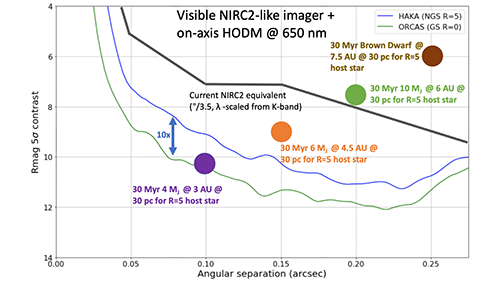Exoplanets
ORCAS will enable four key exoplanet science cases. ORCAS:
- characterize approximately eight known exoplanets from radial velocities (RVs), astrometry, ground-based direct-imaging, and other techniques.
- enable a deeper sensitivity to the zodi levels of approximately eight nearby stars and search for exoplanets around these stars as important precursor studies for a future flagship direct imaging mission such as HabEx or LUVOIR, including the "Deep Dive" HabEx targets.
- uncover the planet formation process in disks around approximately eight young, nearby stars.
- help us constrain the occurrence rates of cool sub-Jovian and super-Neptune exoplanets orbiting approximately a half-dozen nearby cool stars and brown dwarfs, as a precursor to the TMT/ELT era of imaging Habitable Zone M dwarf terrestrial exoplanets.

Science Objectives:
Directly image exoplanets and disks around nearby stars.
Observable and Measurements:
Determine the presence of and characterize exoplanets and disks orbiting nearby stars through high-contrast adaptive optics imaging and low-resolution integral field spectroscopy.
Key Functional Requirements:
Visible (0.5 - 1.0 µm) and Near-Infrared (1 - 2.5 µm) imagers and integral field spectrographs (R ~ 50) with high-order deformable mirror (HODM) adaptive optics, illuminated by the ORCAS laser guide star.
ORCAS Uniqueness:
ORCAS will enable flux contrast improvements not obtainable for most nearby stars. For nearby bright stars of approximately fifth magnitude at visual wavelengths, ORCAS will provide approximately a one magnitude sensitivity improvement with HODM by providing more photons for adaptive optics corrections than available from the host star, equivalent to a zeroth magnitude guide star. For nearby stars fainter than fifth magnitude, ORCAS will enable imaging with the equivalent of a zeroth magnitude natural guide star adaptive optics (NGSAO), offering superior sensitivity compared to LGSAO by several orders of magnitude.
